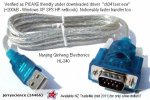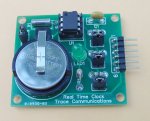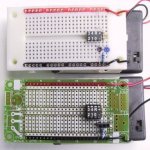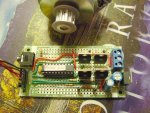8, 14 and 20 pin PICAXEs
- Thread starter Billo
- Start date
hippy
Ex-Staff (retired)
Probably could, but whether Technical would might be a different matter - and I have no idea of any sales volumes or into which sectors.I'm sure that Technical can provide us with at least an indication of the relative sales of each chip.
I suspect they are all popular or we'd not have developed each size as we have and the 8-pin devices are undoubtedly popular not least because the educational kits use them.
The recent poll of forum members is here ...
http://www.picaxeforum.co.uk/showthread.php?19100-New!-Improved!-Better-even!-The-Final-Poll-Part-2
Before you even set outThanks hippy, this is what I'm looking for. Appreciate it very much.
One more question, would using this site to do some market research be against the rules?
have you done some searching?
This has been attempted several times before.
I'll stick to these:
http://www.techsupplies.co.uk/epages/Store.sf/en_GB/?ObjectPath=/Shops/Store.TechSupplies/Categories/PICAXE/PICAXEProjectBoards
and of course, IMHO, the leader
http://www.techsupplies.co.uk/epages/Store.sf/en_GB/?ObjectPath=/Shops/Store.TechSupplies/Products/AXE091U
e
Hi eclectic,
Yes, of course I've tried searching, and a lot more. I have seen these, and other items. However, I do see some drawbacks to a lot of the current offerings and feel I'm offering some unique ways to skin the cat. Not only from my own experience, but from the experience of others. Besides, what would the world be like if there was only one alternative for each item. It's nice to have a choice, especially if it has merit. I will also have offerings in the PIC and AVR worlds such that I'm not putting all my eggs in one basket.
As well, I'd like to offer some more established options as part of my on-line store and plan on including the items you show.
Your input is much appreciated.
I couldn't help but notice your join date. Care to comment?
Yes, of course I've tried searching, and a lot more. I have seen these, and other items. However, I do see some drawbacks to a lot of the current offerings and feel I'm offering some unique ways to skin the cat. Not only from my own experience, but from the experience of others. Besides, what would the world be like if there was only one alternative for each item. It's nice to have a choice, especially if it has merit. I will also have offerings in the PIC and AVR worlds such that I'm not putting all my eggs in one basket.
As well, I'd like to offer some more established options as part of my on-line store and plan on including the items you show.
Your input is much appreciated.
I couldn't help but notice your join date. Care to comment?
I suspect it has something to do with Unix ?I couldn't help but notice your join date. Care to comment?
On a similar basis another OS started on a Tuesday on a specific date in 1980, I remember it well.
Unix and Linux clocks have an 01 January 1970 epoch date. Therefore in the very early days of the forum I suspect that the join date was not a field that was populated. Being a numeric value with a default of zero, it now translates as 01 January 1970.
Think along the lines of early or founder members.
Think along the lines of early or founder members.
westaust55
Moderator
If you have not already done so, please read the Read Me First threadOne more question, would using this site to do some market research be against the rules?
http://www.picaxeforum.co.uk/showthread.php?7679-Read-Me-First
Edit:
There is also the Rev Ed breadboard programming adapter:
http://www.picaxe.com/docs/axe029.pdf
Last edited:
Yes, I read that. I do not intend to advertise, just try to find out what the market is like. No intention of even mentioning my company name.If you have not already done so, please read the Read Me First thread
http://www.picaxeforum.co.uk/showthread.php?7679-Read-Me-First
Seen that too. Thanks.Edit:
There is also the Rev Ed breadboard programming adapter:
http://www.picaxe.com/docs/axe029.pdf
westaust55
Moderator
So the next phase may be to run a poll to determine potential user interest.
Some form of more specific detail on your proposal will be needed
What features will you include that makes it more using that products already available?
Some form of more specific detail on your proposal will be needed
What features will you include that makes it more using that products already available?
This thread seems very much like what I was getting ready to ask about, as I've been tasked with coming up with a purchase order for PICAXE products to display and sell at a retail electronics shop I help out at.
As I typically purchase just the microprocessors and build my projects using the other components available from my own rather large personal stock (thousands - well close to a million actually) of electronic components, I'm unsure what to recommend in the way of suitable project bds and kits for purchase at the shop.
With a limited purchasing budget of around $300 US to start with, I'd like to get both a good variety of PICAXE products and the right number of the most popular components.
The shop is beginning to stock Arduino kits, and I'd very much like to see PICAXE gear prominently displayed as well, so folks have another micro-controller choice (especially as I plan on recommending the PICAXE gear.)
Any suggestions?
As I typically purchase just the microprocessors and build my projects using the other components available from my own rather large personal stock (thousands - well close to a million actually) of electronic components, I'm unsure what to recommend in the way of suitable project bds and kits for purchase at the shop.
With a limited purchasing budget of around $300 US to start with, I'd like to get both a good variety of PICAXE products and the right number of the most popular components.
The shop is beginning to stock Arduino kits, and I'd very much like to see PICAXE gear prominently displayed as well, so folks have another micro-controller choice (especially as I plan on recommending the PICAXE gear.)
Any suggestions?
@JohnW
Just thoughts.
With a small budget, small prices.
http://www.techsupplies.co.uk/epages/Store.sf/en_GB/?ObjectPath=/Shops/Store.TechSupplies/Products/AXE021
08M2 chips.
Have any of your potential customers got
9 pin Serial sockets? If so, cables are easy.
If not, then AXE027 cables.
e
Just thoughts.
With a small budget, small prices.
http://www.techsupplies.co.uk/epages/Store.sf/en_GB/?ObjectPath=/Shops/Store.TechSupplies/Products/AXE021
08M2 chips.
Have any of your potential customers got
9 pin Serial sockets? If so, cables are easy.
If not, then AXE027 cables.
e
hippy
Ex-Staff (retired)
I think it's hard to say what's best to stock and with a limited budget that's somewhere between 150 x $2 items or only 10 x $30 items.
I'd possibly venture AXE201 08 Proto Boards plus 08M2 chips at the bottom price range or PICAXE Starter Kits with AXE027 included in the mid-price range, perhaps the AXE401 Shield Base plus AXE027.
A lot depends on your customers and what it is they are likely to favour or buy.
I'd possibly venture AXE201 08 Proto Boards plus 08M2 chips at the bottom price range or PICAXE Starter Kits with AXE027 included in the mid-price range, perhaps the AXE401 Shield Base plus AXE027.
A lot depends on your customers and what it is they are likely to favour or buy.
Precisely. But with a customer base of everyone from corporate engineering staff to college students it's difficult to envision what will sell. Additionally, as we're the largest (almost only) pure electronics store in Colorado region I think stocking PICAXE products will actually add to the customer base, as those with an interest in mocro-controller projects will have both a place to obtain everything they need as well as discuss exactly how to go about what they want to build.A lot depends on your customers and what it is they are likely to favour or buy.
I also plan on prominently displaying the forum addy on the PICAXE display and including the addy with each device sold, as I see this forum as the most valuable feature of the PICAXE product line. It's quite simply the best tech support in the world for a $3 product.
hippy
Ex-Staff (retired)
Perhaps print a poster ( or two ) of PICAXE products with prices and ask customers what they would be most interested in ?with a customer base of everyone from corporate engineering staff to college students it's difficult to envision what will sell.
It's fair to say many shops act in a "heads up" promotional role, so perhaps first outline the philosophy of the electronics outlet!
Folks often drop by to see (& play!) with the latest goodies, BUT will not always purchase at that outlet-switched on buyers may make significant orders directly from the supplier. In today's global village you can't blame them ! With the rapid delivery Rev. Ed offers (and attractive VAT & GST exempt export/import prices), larger PICAXE orders can be landed here in NZ within mere days, & at prices close to UK retail. Typical of this was a recent large direct schools order of 08M2s,which (even after p&p) cost well under half what the main NZ PICAXE outlet was charging.
Local electronic outlet sales may hence settle at the component "nickel & dime" level, essentially serving cash strapped students or hobbyists. Such a market niche may not cover business overheads,especially in an age when new products rapidly make the previous obsolete,and can hence hardly make the firm's effort worthwhile. (Seemingly as a result of this, the Aus/NZ DSE chain, after decades of being THE place to go, near abandoned all components in favour of higher value "boxes"...)
With these thoughts in mind (& I've been e-importing for some 50 years!),perhaps initially test the waters by focusing on the PICAXE 08M2 & setting up an appealing display. Deals such as "3 for $10" will tempt, but the crunch will be the programming cable. Although a fan of Rev. Ed's AXE027, I've had great mileage from the far cheaper offering below.
Folks often drop by to see (& play!) with the latest goodies, BUT will not always purchase at that outlet-switched on buyers may make significant orders directly from the supplier. In today's global village you can't blame them ! With the rapid delivery Rev. Ed offers (and attractive VAT & GST exempt export/import prices), larger PICAXE orders can be landed here in NZ within mere days, & at prices close to UK retail. Typical of this was a recent large direct schools order of 08M2s,which (even after p&p) cost well under half what the main NZ PICAXE outlet was charging.
Local electronic outlet sales may hence settle at the component "nickel & dime" level, essentially serving cash strapped students or hobbyists. Such a market niche may not cover business overheads,especially in an age when new products rapidly make the previous obsolete,and can hence hardly make the firm's effort worthwhile. (Seemingly as a result of this, the Aus/NZ DSE chain, after decades of being THE place to go, near abandoned all components in favour of higher value "boxes"...)
With these thoughts in mind (& I've been e-importing for some 50 years!),perhaps initially test the waters by focusing on the PICAXE 08M2 & setting up an appealing display. Deals such as "3 for $10" will tempt, but the crunch will be the programming cable. Although a fan of Rev. Ed's AXE027, I've had great mileage from the far cheaper offering below.
Attachments
-
43.3 KB Views: 17
As the business is nominally a surplus outlet (but with new stock of commonly requested items,) I'm not expecting them to make a living selling 08M's. But A PICAXE by itself doesn't do much. I'm thinking that once customers are exposed to the PICAXE products, and see what can be easily done with them, they will then be more likely to purchase the shop's other items as well, everything from wire to proto bds, to soldering irons, resistors, capacitors, FET's, LED's, motion detectors, test equipment, etc.
While I think it's a good business decision for the shop to sell PICAXE products, I actually think it will be even better for Rev. Ed. to have its products displayed before likely customers, especially the many entrepreneurs in the area who might design them into new products, but only if they see them and learn about them.
Boulder, CO is a hotbed of electronics (such as it is these days) in the region. The Arduino kits are selling, so I want to make sure the PICAXE line is also on display.
It appears I'll just need to make a wild guess as to a few items to stock, hope they're the right ones, and present it to the shop manager.
While I think it's a good business decision for the shop to sell PICAXE products, I actually think it will be even better for Rev. Ed. to have its products displayed before likely customers, especially the many entrepreneurs in the area who might design them into new products, but only if they see them and learn about them.
Boulder, CO is a hotbed of electronics (such as it is these days) in the region. The Arduino kits are selling, so I want to make sure the PICAXE line is also on display.
It appears I'll just need to make a wild guess as to a few items to stock, hope they're the right ones, and present it to the shop manager.
Last edited:
Perhaps akin to the NZ firm Surplustronics ?- nominally a surplus outlet-
westaust55
Moderator
I believe that hippy meant the AXE021 proto board for the 08M/M2 chips.I think it's hard to say what's best to stock and with a limited budget that's somewhere between 150 x $2 items or only 10 x $30 items.
I'd possibly venture AXE201 08 Proto Boards plus 08M2 chips at the bottom price range or PICAXE Starter Kits with AXE027 included in the mid-price range, perhaps the AXE401 Shield Base plus AXE027.
I concur that these are a good starting point for work with the 8 pin chips.
The include the programming ccircuit, decoupling cap, provision for an electro for bulk energy storage to help "iron out" voltage dips, and a small proto area big enough for smaller projects such as a radio transmitter, temp sensor etc.
In addition you can cut of the majority of the proto area and retain the PICAXE chip part then solder in a header pin set on the udnerside to enable plugging into a breadboard to provide a ready test platform with the PICAXE 08M/M2 and programming circuit. If you do cut of the proto area, wire links are needed to reconnect the power supply rails.
Consider also how the likes of Littlebird Electronics operate, at least their Australian outlet.
They stock a small number of some items and then advertise as:
XXX available for immediate shipping and YYY for dispatch in 7 days.
The 7 days gives them time to get in the larger quantity.
Okay, let me see if I can give and idea where I'm coming from and what I did to resolve it.So the next phase may be to run a poll to determine potential user interest.
Some form of more specific detail on your proposal will be needed
What features will you include that makes it more using that products already available?
I had some previous Microprocessor experience, some Arduino based Microcontroler experience and some FPGA/CPLD experience too. The idea of the PICAXE was appealing and as I researched it, it seemed it might an ideal platform for 'quickie' projects which actually made up most of what I did. So I ordered up a handful of 8, 14 and 20 pin devices and went Rev Ed's site to see what they offered to help get me started. Well, they had a good array of stuff but by the time I had enough to work with all the chips, I'd need several boards, yet another propriety cable, or a small handful of bits and pieces, that cable and a breadboard. Since my goal was cheap, cheerful and quick neither of these routes seemed ideal. I eventually opted for a small dedicated breadboard with the usual resistors and diode and a modified serial cable. However, this did not seem ideal either. It was a bit of a kludge, I regularly ran out of space on the little breadboard and had to tie in others with jumpers anyway. After a few dozen projects and all the popping of ICs in and out of the breadboard, it started to get unreliable. Also, more than once, I bent the pins on the PICAXE I was using. During all this an idea dawned on me. Why not just build a little board that resolves most of these issues and use it. So this is what I came up with:

The benefits of this were:
- Smaller size
- Uses a common cable I already have (serial or a very cheap USB to serial) and can be used with other things
- ZIF socket to reduce wear and tear on the ICs and the board
- Works with 8, 14 and 20 pin ICs
- Built in regulator to work with cheap DC wall-warts that I can also use with my other MCU/FPGA/CPLD boards
- Still provides access to all the signals
- Quick and easy to set-up, easy to handle and a lot more reliable
When others saw it, they wanted one. It seemed to appeal to most of the folks I showed it to so I decided to get the thing put on a PCB.
Here is the result:
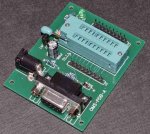
It has the advantage of being even smaller than the prototype and can be sold for under 7 quid fully assembled. It uses all through hole devices so can be easily assembled by someone with minimal soldering skills and could be provided as a board only, a kit, or fully assembled.
I have also done up the design for a "Model 2" that is laid out in a very similar way, and has allowance for regulated DC input, a bigger regulator (like the prototype) and the ability to directly attach and supply power to 3 wire devices like servos and those little 'brick' sensors, switches and other devices. I will have the same design philosophy as the "Model 1" as will all my designs. I have similar projects for the Arduino world too.
So, 2 questions for you all.
1) Would something like this be of interest at all?
2) someone mentioned that this sort of thing had been tried before and failed. Do you have insight as to why they failed?
Thanks in advance to anyone that can give some feedback. I'd also like to find a couple of good folks to receive a free bare board, build it up and let me know what thoughts they have on it.
Last edited:
I like the ZIF socket and agree that would be helpful. I don't care for the DB-9 because of its size and cost, and because the (relatively) cheap AXE026 is already available and is terminated in a stereo plug. I like the built-in regulator, but it does need the provision for battery power. The pin headers for the inputs and outputs are a mixed blessing: good if you have the tools to make up mating connectors, but not so good if you don't.The benefits of this were:
- Smaller size
- Uses a common cable I already have (serial or a very cheap USB to serial) and can be used with other things
- ZIF socket to reduce wear and tear on the ICs and the board
- Works with 8, 14 and 20 pin ICs
- Built in regulator to work with cheap DC wall-warts that I can also use with my other MCU/FPGA/CPLD boards
- Still provides access to all the signals
- Quick and easy to set-up, easy to handle and a lot more reliable
So, 2 questions for you all.
1) Would something like this be of interest at all?
2) someone mentioned that this sort of thing had been tried before and failed. Do you have insight as to why they failed?
Thanks in advance to anyone that can give some feedback. I'd also like to find a couple of good folks to receive a free bare board, build it up and let me know what thoughts they have on it.
I'll volunteer to put one together; I'll even trade you one of my RTC kits for it.
Attachments
-
97.6 KB Views: 17
hippy
Ex-Staff (retired)
The big problem with any board is that while it may suit some needs it doesn't suit others, and it's hard to say what core needs are. People with AXE027 download cables will want to use those rather than 9-way D, and as noted some want to use batteries or 5V bench supplies.Thanks in advance to anyone that can give some feedback.
The AXE091 Experimenter Kit is a very good board for PICAXE development but won't suit ultra-low budgets. The AXE401 Shield Base is very nice IMO but 28-pin PICAXE only.
It's always hard to produce one product which can span development, prototyping and experimenting plus use in final projects as each have different needs. It's perhaps not so much that other efforts have failed but that they haven't necessarily been as successful as hoped. There's always the difficult battle that people don't want to spend a lot of money but expect to get a lot for that money so it can end up that there's a 'perfect product' one way or the other but not a market for it; too little and those who want more aren't interested, too much and those who don't want to pay the price aren't interested, and that's a potential problem anywhere between the two.
At the proverbial end of the day one has to choose a product to sell to a particular market and if you strike lucky it will sell to that market and maybe to others. One thing you usually have to do is analyse what need the product fulfils which isn't addressed already and check that the market sees the same issues, wants them addressing and is prepared to pay the cost of that.
Thanks for your input guys.
Let me explain about the DB9F. While the AXE027 and AXE026 are well made cables and I have nothing against them per se, the fact still remains they are another cable that needs to be bought that has only a single use. If you're like me, you have a number of little gadgets you connect to your computer from time to time. If they all used some different connector, you'd need a pile of cables that you would have to constantly connect and disconnect from the PC all the time. The result would be undue wear and tear on the serial and USB ports on the PC. I know, in terms of size, the DB9F is not ideal, but it is a standard. I also thought of using USB, but then I'd need an FTDI chip and inverters, making thing overly complicated and eliminating it from the kit and bare board markets. I also thought of using the 1/8th" stereo connector, but eliminated that as being non-standard. Besides, as USB to serial cable can be had for less than even the AXE026.
So, there is my reasoning, but your point is well taken and that all being said, there is another design I'm working on right now that will accommodate all the PICAXE chips. It's a much larger platform, so I will include both DB9F and 1/8" on it. I'll also look at seeing if I can allow for either the DB9F or the 1/8" on future versions of the PICAXE boards. That way I can offer both.
@tracecom. Thanks for volunteering. PM a mailing address and I'll get one out to you. I'll include a DB9F with it since I have quite a few and can get them for under $0.25. The only part I don't have right now is the ZIF, so I'll drop everything except it into the bag for you. And yes, I'd be delighted to try out your RTC.
Let me explain about the DB9F. While the AXE027 and AXE026 are well made cables and I have nothing against them per se, the fact still remains they are another cable that needs to be bought that has only a single use. If you're like me, you have a number of little gadgets you connect to your computer from time to time. If they all used some different connector, you'd need a pile of cables that you would have to constantly connect and disconnect from the PC all the time. The result would be undue wear and tear on the serial and USB ports on the PC. I know, in terms of size, the DB9F is not ideal, but it is a standard. I also thought of using USB, but then I'd need an FTDI chip and inverters, making thing overly complicated and eliminating it from the kit and bare board markets. I also thought of using the 1/8th" stereo connector, but eliminated that as being non-standard. Besides, as USB to serial cable can be had for less than even the AXE026.
So, there is my reasoning, but your point is well taken and that all being said, there is another design I'm working on right now that will accommodate all the PICAXE chips. It's a much larger platform, so I will include both DB9F and 1/8" on it. I'll also look at seeing if I can allow for either the DB9F or the 1/8" on future versions of the PICAXE boards. That way I can offer both.
@tracecom. Thanks for volunteering. PM a mailing address and I'll get one out to you. I'll include a DB9F with it since I have quite a few and can get them for under $0.25. The only part I don't have right now is the ZIF, so I'll drop everything except it into the bag for you. And yes, I'd be delighted to try out your RTC.
Here is something I came up with the other day. Inexpensive and allows quite a bit of versatility with the two header strips. I like the way it doesn't block a lot of the board.
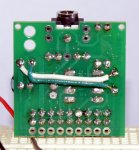
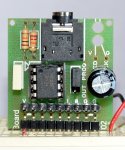
Since all the projects I have made include a programming header I don't see the need for a ZIF socket. I configure and test with a device like the one above or a AXE091 board then build the result on a PC board. The operating chip is programed on the operating board. The only PICAXE chip changes I tend to do are changing between a 08 and 20 on the AXE091 board.
I'm not really a fan of the 1/8" plug/jack for programming. I prefer a 3 pin header due to size, cable weight and ease of use. I understand the educational environment and see why the decision was made but...
@tracecom - Nice RTC. Do you have a DS3231 version?


Since all the projects I have made include a programming header I don't see the need for a ZIF socket. I configure and test with a device like the one above or a AXE091 board then build the result on a PC board. The operating chip is programed on the operating board. The only PICAXE chip changes I tend to do are changing between a 08 and 20 on the AXE091 board.
I'm not really a fan of the 1/8" plug/jack for programming. I prefer a 3 pin header due to size, cable weight and ease of use. I understand the educational environment and see why the decision was made but...
@tracecom - Nice RTC. Do you have a DS3231 version?
Last edited:
The PICAXE friendly Kiwi Patch Board may have some mileage? These allow simple "paint by number" lift over of tamed breadboard layouts & have become extremely popular here in NZ, especially for prototypes & one offs. The resulting assembly looks very professional.
Attachments
-
49 KB Views: 16
-
68 KB Views: 18
Thanks for the compliment; no DS3231 version, but I have been wanting to dip my toe into SMD, so maybe I should start with that.@tracecom - Nice RTC. Do you have a DS3231 version?
Here's my one build on the Kiwi board.The PICAXE friendly Kiwi Patch Board may have some mileage?
Attachments
-
99 KB Views: 27
Last edited:

